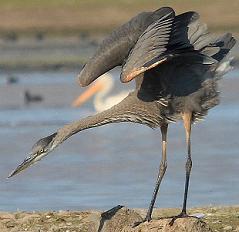Great Blue Heron 
Identification and Pictures
(Ardea herodias)
The Great Blue Heron is a lean, blue-gray bird
with chestnut on the thighs, which stands 4 feet tall, and is
42 to 45 inches. It is the largest heron in North America.
Their long legs, long neck, and long, sharp, orange bill are
all well suited to their habit of wading, and fishing. The
adults have a shaggy ruff on their neck, and show white around the
head. In breeding plumage they may have plumes.
They have a 6 foot wing span, and fly with their neck
folded in an s shape, and the legs trailing behind. The
sexes look similar. Young birds are duller in color, and
have a dark gray crown. Herons are often seen standing
motionless with the head either erect or between the
shoulders. Although they may stand 4 feet tall they
usually only weigh around 5 pounds because they have hollow
bones. These birds are often mistaken for
cranes.
Photos by Keith
Lee. The camera I use is the Canon
EOS 40D. 
Sound
The Great Blue Heron's voice is a deep harsh
croak. Sound
Preferred Habitat
Great Blue Herons range across most of North
America. They can be found near water sources such as
swamps, lakes, rivers, shore lines, and tidal flats. Northern
populations may be migratory while birds in others areas are
year round residents.
Breeding and Nesting
At the beginning of the nesting season the
male chooses a territory, and does displays to attract a
female. Herons usually nest in large colonies called heronries,
but may nest as lone pairs. For a nest they build a
stick platform lined with moss, grass, bark strips, and twigs
usually in a tree or bushes, but sometimes on a cliff edge or
in reeds. The female lays 3 to 6 bluish eggs. The
parents will take turns incubating the eggs for around 30
days. Both adults will feed and care for the young birds
which will fledge in about 2 months. The young birds
will return to the nest to be fed for an additional
week. A pair only raises one brood each year.
Food 
Herons feed mostly on fish but also eat
things like frogs, salamanders, small mammals, birds, crabs, crayfish,
and insects. They have two methods of foraging. In
one method they stand still until they see their prey, then
they strike swiftly with their dagger like beak, grabbing or
impaling it. They also stock their prey, wading slowly until they are in striking distance. They fish
both night, and day however they are more active during mornings
and dusk because these are the best fishing
times.
To learn about other favorite
birds click here.

|
